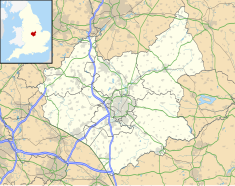Leicester Corn Exchange
| Leicester Corn Exchange | |
|---|---|
 Leicester Corn Exchange | |
| Location | Market Place, Leicester |
| Coordinates | 52°38′04″N 1°08′00″W / 52.6345°N 1.1333°W |
| Built | 1855 |
| Architect | William Flint and Frederick Webster Ordish |
| Architectural style(s) | Neoclassical style |
Listed Building – Grade II* | |
| Official name | Corn Exchange |
| Designated | 5 January 1950 |
| Reference no. | 1361417 |
Leicester Corn Exchange is a commercial building in the Market Place in Leicester, Leicestershire, England. The structure, which currently operates as a public house, is a grade II* listed building.[1]
History
[edit]The first building on the site, known as The Gainsborough, which was built as a prison and law court with shops and dungeons below, was completed in 1509. It was replaced by another building, known as the New Gainsborough, which was built as a corn exchange, in 1748.[2][3] The first floor of the building was used for magistrates' court hearings.[4] The current building was originally commissioned as a single-storey market trading hall. It was designed by William Flint and completed in 1851. However, it was then extended by the addition of an extra floor to accommodate magistrates' court hearings, to a design by Frederick Webster Ordish in the neoclassical style, in brick with a stucco finish, in 1855.[1]
The design involved a symmetrical main frontage of seven bays facing onto the Market Place. It featured a prominent stone archway supporting a double-flight staircase providing access to a doorway on the first floor in the piano nobile-style. The first floor doorway was surmounted by a segmental pediment and a cartouche. The wings were fenestrated by tall windows with window sills, architraves and alternating segmental and triangular pediments on the ground floor, and by square-shaped windows on the first floor. At roof level, there was a modillioned cornice. A clock turret was also added, housing a clock by E. T. Loseby of Leicester[5] and topped by a weather vane in the shape of a wyvern.[3] The architectural historian, Nikolaus Pevsner, described the staircase as "spectacular",[6] although Ordish had his doubts about it and later disowned it.[7]
A statue of the Lord Lieutenant of Leicestershire, John Manners, 5th Duke of Rutland, sculpted by Edward Davis, was unveiled outside the building by Sir Frederick Gustavus Fowke, 1st Baronet on 28 April 1852.[8][9][10]
The use of the building as a corn exchange declined significantly in the wake of the Great Depression of British Agriculture in the late 19th century.[11] However, in the early 20th century, the building served as a focal point for civic celebrations and, in June 1911, a large crown attended celebrations to mark the Coronation of George V and Mary.[12] Then, in August 1914, at the start of the First World War, the building was the venue for a lively debate involving the future Prime Minister, Ramsay MacDonald, who spoke on the importance of democracy and overcoming militarism.[13]
After a long period when the building was vacant and deteriorating, it was acquired by Wetherspoons and, after a major refurbishment, it re-opened as a public house in July 2000.[14]
See also
[edit]References
[edit]- ^ a b Historic England. "Corn Exchange (1361417)". National Heritage List for England. Retrieved 14 April 2023.
- ^ "Corn Exchange (Leicester)". Colin Crosby Heritage Tours. Retrieved 14 April 2023.
- ^ a b Ashe, Isaac (29 February 2020). "The fascinating history behind Leicester city centre's two JD Wetherspoon pubs". Leicestershire Live. Reach PLC. Retrieved 14 April 2023.
- ^ "Leicester Exchange (Magistrates)" (PDF). Leicester Chronicle. 19 December 1840. Retrieved 14 April 2023.
- ^ Daniell, J. A. (1951). "The Making of Clocks and Watches in Leicestershire and Rutland" (PDF). Transactions of the Leicestershire Archaeological Society. 27: 41–42. Retrieved 12 April 2023.
- ^ Pevsner, Nikolaus; Williamson, Elizabeth; Brandwood, Geoffrey (1985). Leicestershire and Rutland (Buildings of England Series). Yale University Press. p. 223. ISBN 978-0300096187.
- ^ "Opening of Messrs. Evans and Stafford's Warehouses". Leicester Guardian. 25 September 1858. Retrieved 21 November 2021.
- ^ "John Henry Manners, 5th Duke of Rutland". Vanderkrogt. Retrieved 14 April 2023.
- ^ Historic England. "Statue of the Duke of Rutland (1073991)". National Heritage List for England. Retrieved 14 April 2023.
- ^ "The History of Leicester's Statues: John Henry Manners". Leicester Chronicle. Retrieved 14 April 2023.
- ^ Fletcher, T. W. (1973). 'The Great Depression of English Agriculture 1873-1896' in British Agriculture 1875-1914. London: Methuen. p. 31. ISBN 978-1136581182.
- ^ "When Leicester's Corn Exchange was focal point for city celebrations". Leicester Mercury. 11 October 2018. Retrieved 14 April 2023.
- ^ Gamble, Mark (2018). "When 'Germany Called the Tune': Music, Liberalism and the Call to War" (PDF). Leicestershire Historian. Leicestershire Archaeological and Historical Society. p. 17.
- ^ "Leicester Wetherspoon pub The Corn Exchange re-opens after huge refurbishment". Leicester Mercury. 23 September 2022. Retrieved 14 April 2023.

